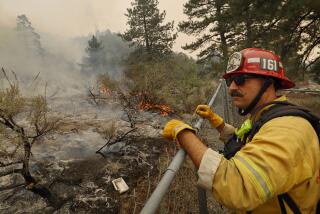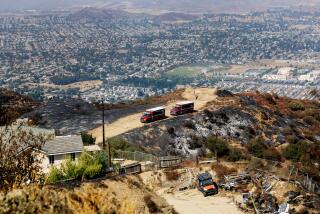Wildfires meet containment lines in New Mexico, winds in Colorado
- Share via
Wildfires that have burned for days in the mountains of New Mexico met resistance Wednesday from containment lines days in the making, forest officials said.
The largest fire in New Mexico history, which has devoured more than 435 square miles of bluff country, jumped from 37% to 51% containment overnight Tuesday, according to official reports. Crews confirmed the progress after seeing no smoke or flames along major fire lines, which they had dug or pre-burned days ago.
“We’re still not completely out of the woods,” Dean McAlister, an information officer for the Whitewater Baldy fire, told the Los Angeles Times. “But barring unforeseen winds, we shouldn’t have a problem from now keeping it where we want to.”
Although conditions remain hot and dry, the remaining uncontained perimeter is primarily in remote areas of New Mexico low country. Rocky terrain and scrubby brush tend to deter strong wildfires, McAlister said. The number of crews fighting the fire has dropped to about 500, and the hot-shot crews that fight the truly volatile spots have moved on.
In Colorado, temperatures and winds are picking up, a bad sign for the crews fighting the High Park fire near Fort Collins. Authorities said the fire, which had burned 72 square miles by Wednesday, had cost more than $3 million, including equipment costs and salary for firefighting staff.
As of Wednesday afternoon, the fire was 10% contained.
Pre-evacuation notices were issued for a number of housing developments on the western edge of the fire, where the blaze remains unpredictable. The west side continued to burn dangerously close to forests where up to 70% of trees have been ravaged by a mountain pine beetle epidemic, spokeswoman Reghan Cloudman said in an interview with The Times.
Further, dark smoke has begun to rise again from the foothills. That means something is burning hot, not just smoldering, Cloudman said. Heavier timbers take longer to catch fire but burn hotter and longer than brush and grasses.
Gov. John Hickenlooper declared a state of disaster, allotting $20 million in state funding and the use of the Colorado National Guard. The fire is the third-largest in state history.
Earlier this week, authorities found the body of Linda Steadman, 62, in the ashes of her cabin on the edge of the Roosevelt National Forest. Steadman’s death, the first in the High Park fire, is the state’s fourth wildfire fatality this year.
In New Mexico -- to the east of the Whitewater Baldy fire -- crews made progress against another fire that had destroyed 224 homes and consumed 56 square miles of land near the Lincoln National Forest. The southern edge of the fire borders Ruidoso, a town of 8,500 people, and crews focused their attention there, officials said.
The outlook for the Little Bear fire was more promising than it had been in days past, spokeswoman Loretta Benavidez said. Crews had not seen walls of flames. Some burned-out areas turned cold. Columns of smoke and the telltale nighttime glow of strong fires faded.
As of Wednesday afternoon, the fire was 35% contained. Should humidity stay up and winds down, firefighters will make more progress overnight, Benavidez said.
ALSO:
Vroom! Texas considers 85 mph speed limit, nation’s highest
Auburn shooting suspect surrenders -- with snipers standing by
Follow Laura on Twitter or Google+. Email: laura.nelson@latimes.com
More to Read
Sign up for Essential California
The most important California stories and recommendations in your inbox every morning.
You may occasionally receive promotional content from the Los Angeles Times.














